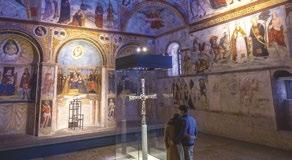
2 minute read
Brescia city of art
A stratified city
From the Bronze Age to the skyscrapers symbolising today’s entrepreneurial spirit, passing from the time where Brescia was a religious and economic capital under the Cenomani Gauls and the Romans, the Lombard domination, and Charlemagne’s Franks. And then, centuries under Venetian rule, Austrian domination, and the final annexation to the Kingdom of Italy. Today, the Venetian style of Piazza della Loggia narrates the years of the Serenissima rule; in Piazza Paolo VI - with Duomo Nuovo, Broletto, and Duomo Vecchio standing side by side - traces of Baroque, Neoclassic, and Romanesque styles coexist. The formal rigour of Piazza della Vittoria is an example of Fascist-age rational architecture, while the Castle of Brescia, with its surface of 75,000 sq m, is known as one of the most complex fortified constructions in Italy.
Roman Brixia
Brought back to life thanks to the excavations of 1823, the archaeological area where the Capitolium Temple stands boasts the record of largest Roman archaeological site in northern Italy. Today prehistoric artifacts and Roman objects found inside the Capitolium are displayed in the Santa Giulia Museum, while famous bronze sculptures such as the Winged Victory have been restored to their original position in the temple. Next to the temple are the rests of the Roman Theatre and the buildings representing the civic and economic life of Roman Brescia, such as the Forum - the commercial square - and the Basilica - the tribunal where justice was administered.
Brescia is identified as one of the capitals of the Lombard Kingdom created by Alboin and was chosen by him as the seat of one of its 36 dukedoms. The last Lombard king was Desiderius, to whom we owe the construction of two very significant Benedictine monasteries in the province of Brescia: a male convent in Leno and a nunnery in the city, called San Salvatore (subsequently dedicated to St. Giulia) which today hosts the City Museum. Together with Brixia - Parco Archeologico di Brescia romana (Roman Brescia Archaeological Park), the Santa Giulia Museum has been a UNESCO World Heritage Site since 2011 as part of the serial site “Longobards in Italy. Places of Power (568-774 A.D.)” and displays 11 thousand artifacts and artistic objects including the invaluable Desiderius Cross.


Santa Giulia Museum
Renaissance in Brescia
Under the rule of the Serenissima Republic of Venice (1426-1797), medieval Brescia started to gradually transform its architecture and culture to become a Renaissance city. Piazza della Loggia epytomises this evolution: a remarkable example of Lombard-Venetian Renaissance style, the square was built at the end of the 15th century and became the administrative heart of the city. The symbol of the city’s transformation is Palazzo della Loggia, built over the foundations of a Late-Gothic building. In addition to the Palazzo, the square is lined with porticoes, Monti di Pietà (pawn shops), and the Clock Tower, other examples of monumental style and of the splendour of Brescia’s Renaissance Age.









